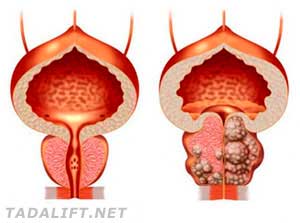Adenoma or benign prostatic hyperplasia (BPH) is a noncancerous growth of the prostate. It is an illness that develops in the bulk of men who have reached the age of 50 or even younger. Hence, the risks grow as the man gets older. Except for the age, there are some other things that increase your predisposition to the disease:
- A close family history of BPH;
- Excessive weight and obesity;
- Cardiological problems;
- Diabetes.
The first signs of the disease
Men may start noticing problems even if the prostate is only slightly bigger than the norm. On the contrary, in some cases, the size of the gland may be very big, whereas the manifestations are light to moderate. Hence, it’s all very individual. Nevertheless, you’d better consult with a specialist in case you’ve noticed:
- Difficulties with passing the urine (need to strain or push to start urinating);
- Weak or intermittent stream;
- Inability to empty the bladder completely;
- Need to urinate too often;
- Dribbling at the end of the urination.
All these may signal about the prostate enlargement. To avoid complications and get back to the normal way of life, you have to start the treatment.
 Possible threats caused by BPH
Possible threats caused by BPH
At first sight, this illness is not dangerous. Yet if left untreated, benign prostatic hyperplasia may result in some complications, which are far more difficult to cope with. Besides, a number of outcomes of the ailment may be life-threatening.
As one cannot empty the bladder completely, the urine left in the organ start irritating it. As a result, you can have frequent urinary tract infections. Furthermore, because of the continuous load on the bladder muscles, they get weaker. Hence, the problem of getting wet gets acute.
The probability of kidney stones formation is also much higher in males with enlarged prostate compared to their healthy peers.
In severe cases, when the disease has been progressing without any medical attention, men may face with complete urinary retention. This may be dangerous to life that’s why men have to seek emergency help if they cannot pass the urine at all.

